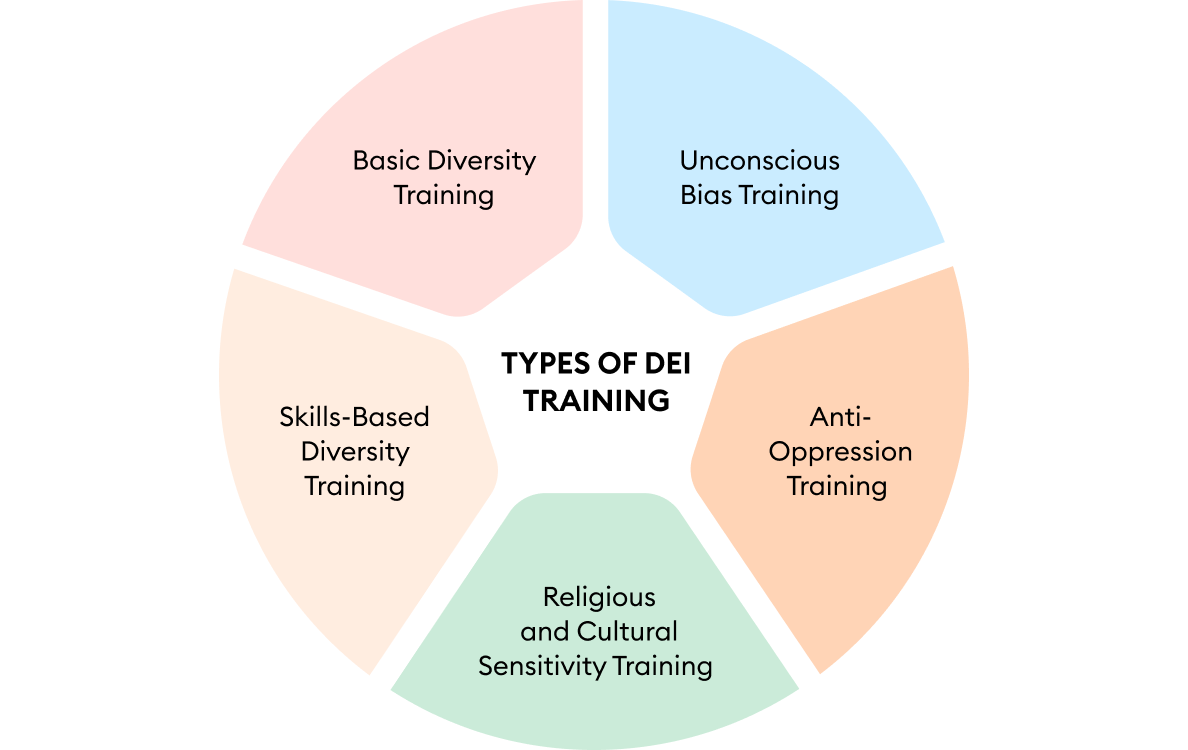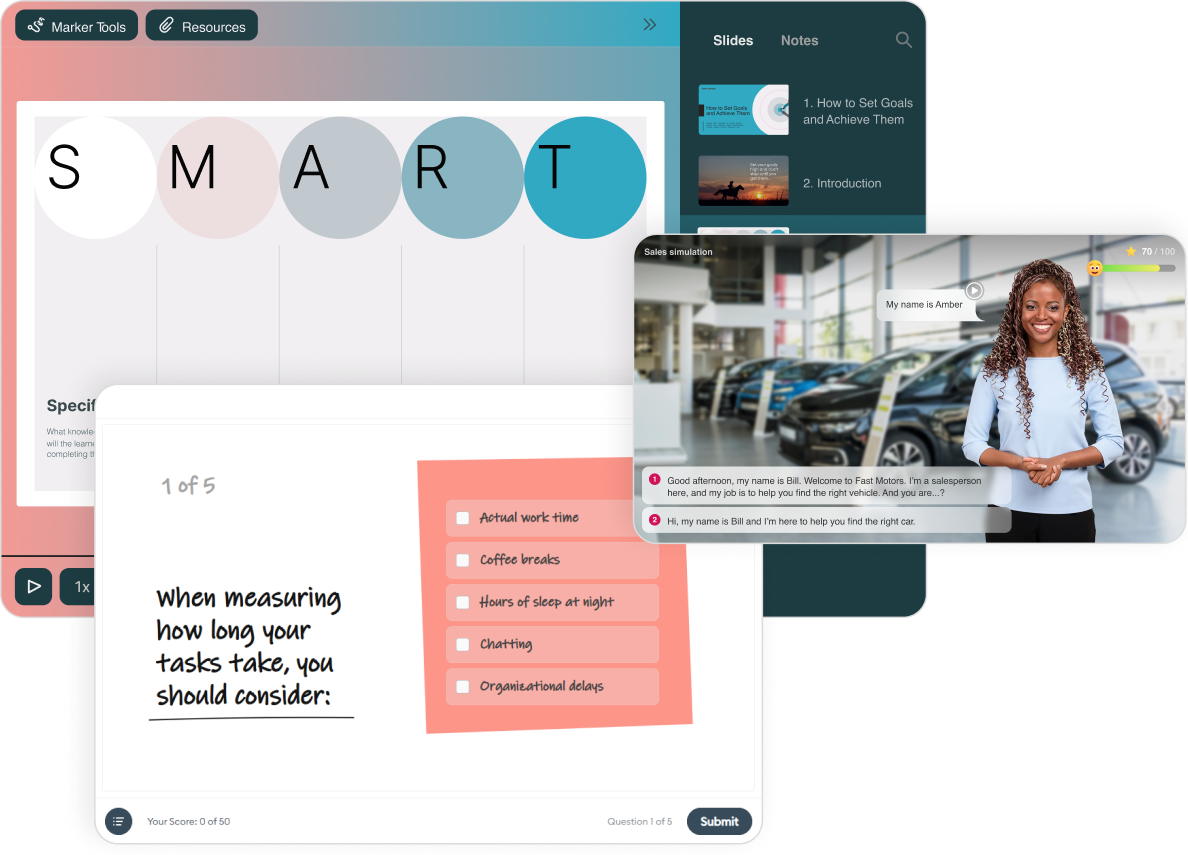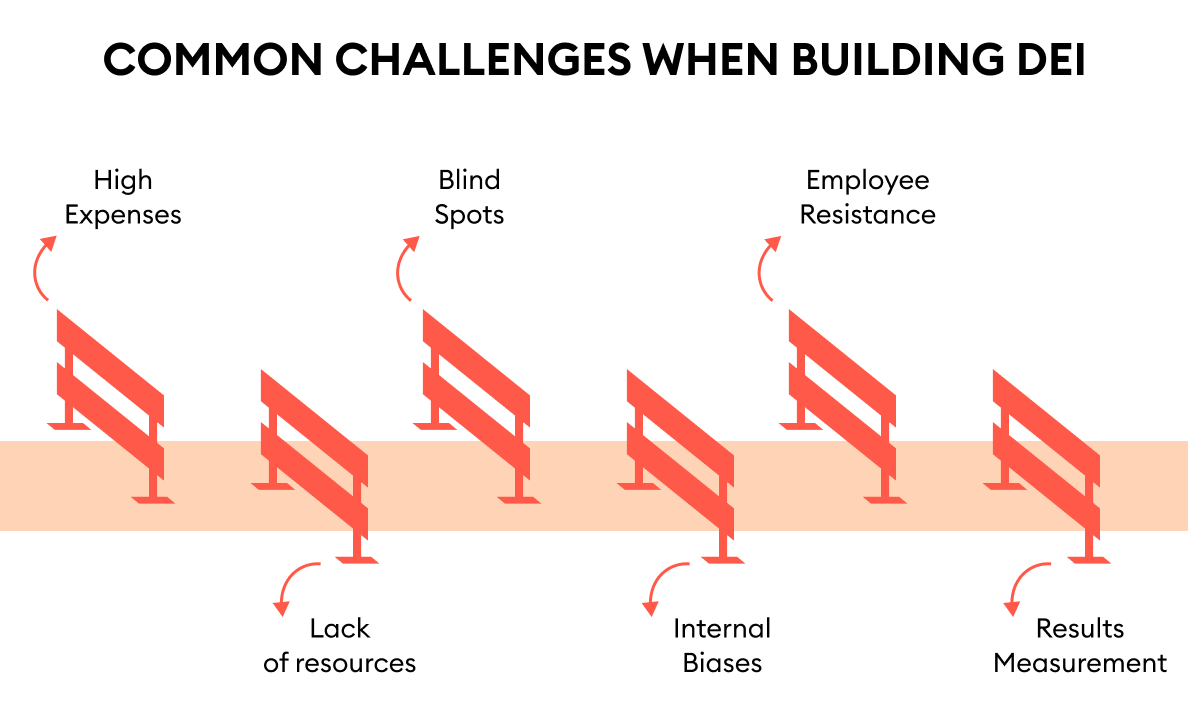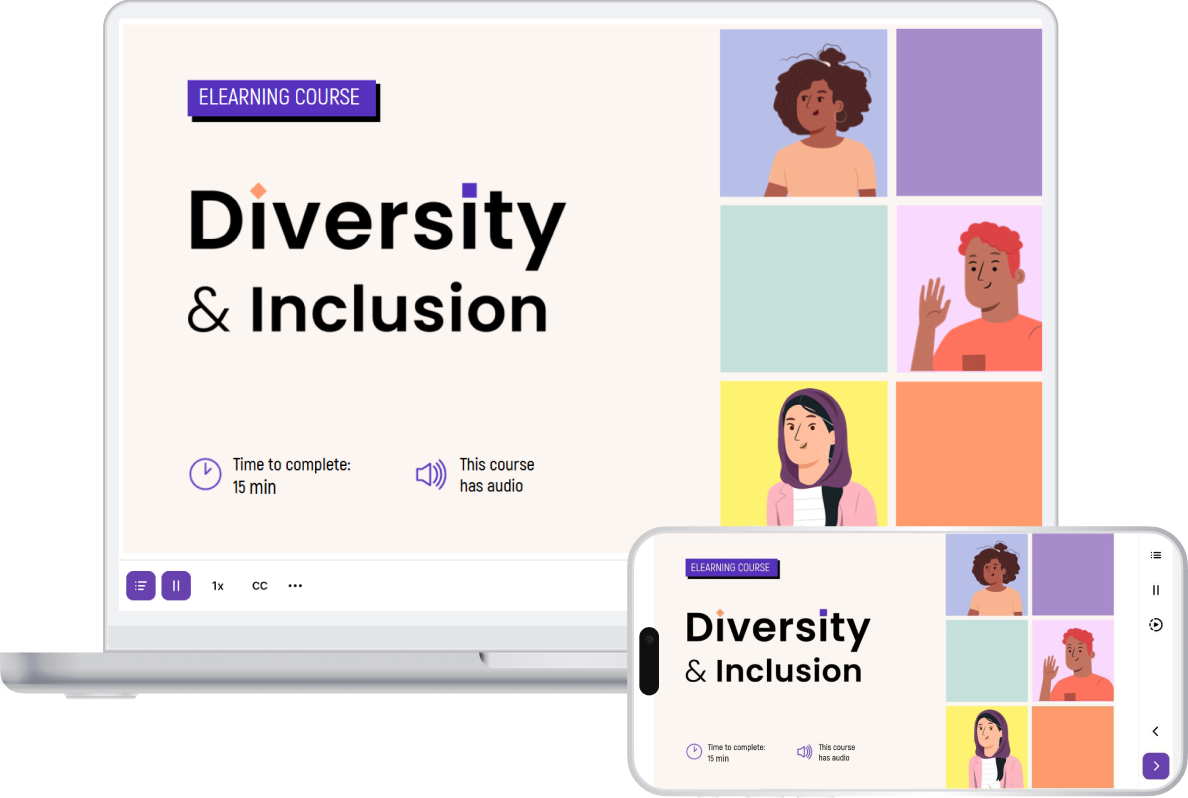Why DEI Training Is Important: TOP Reasons and 5 Best Practices

After its peak in the post-COVID 2020s, DEI (Diversity, Equity, and Inclusion) policy became one of the essential parts of business growth campaigns. And even though around 60% of executives currently consider that building and adapting their DEI programs is challenging due to the current political and social climate, 73% of leaders claim that today, DEI is even more important than 5 years ago.
That’s is why we prepared this article — to share our insights on why DEI training is important and how to improve your DEI (and business performance) in 2025.
Core DEI Idea: 3 Key Pillars
DEI training focuses on fostering Diversity, Equity, and Inclusion in a business’ routine life. Thanks to this initiative, businesses provide a more equitable and inclusive work environment for diverse kinds of talent. By successfully meeting all these criteria, businesses boost their talent’s diversity of intelligence, enhance employee engagement, and grow their income thanks to innovative approaches. Let’s dive deeper into each part of DEI.

Diversity
Diversity implies recruiting and hiring talent regardless of their race, ethnicity, gender, religion, sexual orientation, age, and more. It is a must to embrace these values, and they should be included in HR compliance training.
Equity
Equity basically means equal opportunities, the same access to resources, and an equal level of support and help to all the diverse groups of people mentioned (and not mentioned) above. As we face different barriers, everyone deserves to be heard and supported.
Inclusion
To form a high level of diversity and equity, organizations should create an inclusive working environment where all the different employees feel valued and safe, can support each other, and easily eliminate any kind of discrimination.
To develop the perfect DEI atmosphere, businesses need to develop various ways of promoting these values to their employees, and DEI training is one of the best ways to do it. So, it’s time to see how it works.
Types of DEI Training
While being a universal paradigm that any business needs, DEI can require different approaches to corporate training to release its full potential. Here, we explain the five most popular types of DEI training so you can readily adopt them with your inclusive teams.

1. Basic diversity training
Basic diversity training equally relates to explaining to employees the key (basic) values of the business and showing them what builds basic diversity in the company. This is the very first training the HR team must provide when onboarding a new team member. Besides displaying the core local values and peculiarities of the team, this training often includes three basic diversity principles recognized globally.

Anti-racism
One of the reasons racism still exists is that businesses often focus on addressing individual employee behavior, protecting specific employees in isolated cases, rather than fostering a culture of zero tolerance for racism. Effective anti-racism training, however, must also drive some systemic changes.
Anti-sexism
Although significant progress has been made in gender equality over the last two decades, men still earn more than women, and women face stereotypes 7 times more often than men. Bridging gaps — ranging from respect for opinions in an inclusive workplace to wage disparities — requires anti-sexism training as an integral part of foundational DEI efforts.
Anti-ableism
Among underrepresented groups of employees, disabled employees are 20% less likely to feel like they belong and 16% less likely to feel engaged. This often occurs because of some conscious and unconscious biases against disabled people. Anti-ableism DEI training is intended to extinguish this biased attitude and retain great specialists on the team.
2. Unconscious bias training
According to Bridge Partners’ 2024 Inclusion Barometer, over half of businesses still measure DEI success based on race and ethnicity, which are often openly expressed. While these foundational aspects are important, they are not the only ones. Let’s explore what else lies beneath the surface but prevents businesses from being resilient and efficient.

Ageism
This problem can be hidden in both informal communication and formal processes, like recruiting. Almost 60% of older employees believe they didn’t get a position due to their age. On the other hand, many people believe they don’t get a promotion because their leaders consider them “too young.”
Beauty bias
Also known as lookism, beauty bias means that people considered more physically attractive get more work opportunities, as their level of skill is often believed to correspond to their appearance. Blind CVs can resolve a big part of the issue, but without training your employees in equality, it won’t change anything globally.
These “blind” biases can be easily addressed by mentorship because most unconscious biases come from precious psychological experience; this is why DEI training is important.
3. Anti-oppression training
Although 58% of companies have trained teams to identify unconscious biases, employees still encounter corporate oppression in a variety of ways.

Microaggressions
Having racial or gender biases is negative, but trying to be “polite” when hiding it is no better. Imitating the accent of a colleague or slight, often unintended comments like “you’re pretty for a dark-skinned girl” is a microaggression. Such behaviors cannot be changed in a day but must be addressed through continuous empathy learning.
Sexual harassment
This includes more than sexual advances and direct actions. Commenting on a colleague’s body or using sexually explicit language is also a form of harassment. To eliminate it, you need to build a trustworthy and inclusive culture.
4. Religious and cultural sensitivity training

Modeling behavior
Presenting real-life scenarios to challenge assumptions is good, but employees will still look toward their leaders. So, training your leaders to demonstrate respectful behavior is key.
Celebrating diversity
At the end of the day, aloof and indifferent leadership can be one reason that teams are held back from building an inclusive environment. Always celebrate diversity and the achievements of your employees, regardless of their differences.
5. Skills-based diversity training

To address all DEI gaps, your training must provide your employees with three basic skills. Here they are:
Awareness
The more they know, the fewer stereotypes they will have. Make an effort to teach your teams about other cultures, religions, and more through awareness training — this will pay off quickly.
Empathy
After your teams become aware of how different the world can be, it’s time to introduce empathy and emotional intelligence in your training. Being aware of a certain colleague’s past and being empathetic keeps employees from committing microaggressions and expressing their stereotypic bias.
Communication
Here is the last piece: developing your team’s communication skills can lead to better understanding between colleagues and bring results quickly.
Key Benefits of DEI Training
Besides improving employee relationships and the overall environment, DEI provides many more benefits for businesses. Here, we list some of the advantages you can realize by applying the best DEI practices to your teams.

Employee happiness and increased retention
According to PRNewswire, 94% of business leaders believe that a robust DEI program has a very positive impact on recruiting, hiring, and retention. The importance of DEI training is evidenced by employees as well: 80% claim they will stay in a company that values DEI issues.
Diverse talent pool
As various employees with a wide range of skills join the company and stay, businesses spend less to find the exchange for their key team players. The recruiting process also becomes easier because the talent pool is much bigger when the company shares DEI values. This means that businesses and talents have more chances to find each other. Over half of Americans believe that diversity, equity, and inclusion efforts in the workplace generally helped educated and talented women and men of color find their place in the corporate world.
Growing brand awareness and reputation
Let’s examine other practical benefits that businesses can realize and look into brand awareness. McKinsey claims that over half of diverse leadership teams could help bolster community involvement and the general image of a company. The happier employees and customers are, the deeper the connection that is built between the business and the community.
Continuous innovation
The DEI atmosphere engages with employees’ feelings of safety. Along with a diverse talent pool, the freedom to express oneself helps staff to open up their out-of-the-box thinking and furnish greater results. At the same time, inclusion supposes hiring people with diverse backgrounds and makes it possible to build a superior team of innovators.
High productivity and profits
It has been proven that companies devoted to ethnic diversity show an average of a 27% financial advantage over others, and diverse teams are 70% more likely to capture new markets. Companies with greater diversity can outperform competitors financially 2.4 times over. Why does this happen? Besides the high level of employee openness and readiness to innovate, diverse teams also offer better reach to new markets and communities, a wider understanding of how to reach them, and more.
We bet you’re already thinking about implementing DEI initiatives in your teams. So here are some great ideas on where to start.
5 DEI Initiatives to Implement in 2025
Over 98% of US Fortune 500 companies including Google, Meta, and Microsoft have implemented efficient DEI training programs and provide mentoring programs to their employees to some degree. Here are five best practices that all these companies use.
Conduct a diversity audit
Start by discovering your DEI gaps and identifying the actual business goals. Ask your employees what they would improve and compare the results you get against industry standards, which are published in big tech companies’ reports. This step can help build a roadmap for your corporate training models.
Create and test your ideal DEI training
Tailor DEI training to your organizational needs discovered during the audit. Modern learning management systems can help you create engaging courses and different types of training programs, test them, and assess learner results.
A nice starting point is to use existing courses from expert companies. For example, you can try the iSpring Academy’s Diversity and Inclusion eLearning course, that includes detailed info on all DEI values and useful examples of how DEI works in real life.
When you achieve some experience in how such training works and have a better understanding of what you need, you’ll be able to select the right tools to create your own training. Looking back at the course you just tried, we used iSpring Suite — the eLearning authoring tool that allows you to create interactive courses from PowerPoint slides.
Engage with your employees and promote diversity
Remember that building a DEI-based environment is a collaborative process. Engage with your teams during the planning of future DEI initiatives, and encourage them to participate more. What’s particularly important is to invite your employees to share their subject matter expertise (They have a lot!). To do this perfectly, skills mapping can be helpful.
Create a continuous feedback loop
Keep asking your employees to provide feedback, and remember to provide yours. One-to-one meetings, anonymous polls, team games, and large-scale feedback sessions can transform everything, as the essence of inclusion and equity is about listening to each team member and constantly exchanging ideas.
Make DEI training accessible
One of the biggest challenges in every training process is to convince your teams that learning is easier than it seems. While most people still want to learn something new, some tire quickly and need smaller and more convenient learning formats. Use microlearning and mobile learning to make it accessible on the go, add gamification, and stay aware of the latest learning trends. This will definitely increase employee engagement, which will lead to greater learning results.

Start your DEI journey with iSpring Learn to build a perfectly inclusive environment that strengthens your team and skyrockets your business.
Overcoming Challenges in DEI Training

While the benefits of DEI training are obvious, it’s still challenging to embed the idea in new teams. There are plenty of factors that will keep you from building the perfect DEI, from high expense to employee resistance. Almost 30% of businesses are still struggling to build their DEI programs due to the blind spots in their justification for implementation, and 20-25% lack the human and economic resources to roll it out. However, there are ways to win this battle. Here are some expert tips that have helped business leaders overcome every challenge and find their DEI way.
Ensure leadership support
Without a visible commitment from executives, DEI efforts risk becoming superficial or ignored. Leaders should also signal that DEI is a priority, not just an HR checkbox, and talk about diverse perspectives. That’s why compliance training is also important.
Address resistance and foster open communication
Employee pushback often stems from misunderstandings or fear of change. Work with these objections through data and storytelling, and you’ll turn skeptics into allies.
Automate performance evaluation
Manual tracking of DEI progress is inefficient and prone to bias. The best way to eliminate human error and get correct analytics is a data-based approach. Look for an LMS that will collect data on each training, provide 360-degree performance appraisals, and visualize results. This will help you track employee success and predict what changes the training will need in the future to provide better upskilling and greater engagement.
Provide ongoing training
This is a very important point because many businesses provide short and incoherent training. Keep in mind that in order to remember and accept everything the company transmits, employees need information and time. Make your training process continuous: suggest having 5-minute bias checking before meetings or offer scenario-based drills in the middle of the day. Of course, constant access to materials and mentorship work as effective elements.
Don’t forget to celebrate successes
Employees not only want to learn more, but they also expect some positive reactions and proof of the importance of DEI training. Providing positive feedback and celebrating successes increases the retention rate and helps make the process of individual training and effectiveness transparent. Share metrics, spotlight employee achievements, and reward the most active employees, and you’ll see that others will do what is needed to get the same treatment.
Integrating DEI Into the DNA of Your Business
DEI training is not a universal solution to all your business issues, but is an ongoing commitment to improve. One issue is that most DEI ideas across the web are taken from other businesses and don’t address an organization’s unique challenges and opportunities. To drive real change, you have to adapt your DEI training, and this means you’re going to need the appropriate tools.
A robust learning management system like iSpring Learn is one solution. Whatever route you choose — using ready-made courses as a starting point and adapting them to your needs or creating your own training — iSpring Learn will provide a smooth workflow for both trainers and trainees, collecting data, analyzing and visualizing it, and much more.
Want to learn how iSpring Learn can help you organize your DEI training? Book a free demo right away!







